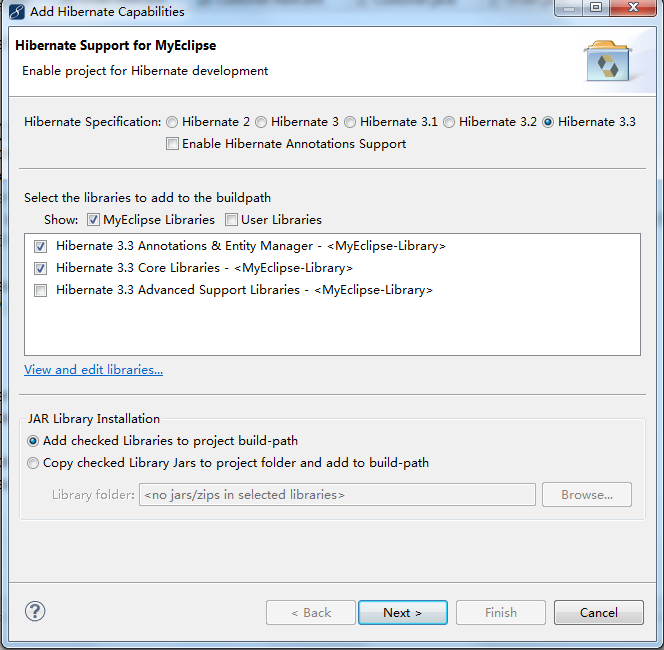反向工程:先创建表,创建好表之后,就是持久化类和映射文件可以不用你写,而且你的DAO它也可以帮你生成。但是它生成的DAO可能会多很多的方法。你可以不用那么多方法,但是它里面提供了这种的。用hibernate,必须得用myeclipse里面的这种自动生成的工具。其实myeclipse它里面对Struts和Spring都有集成。但是这种集成对三大框架整合的时候会有问题。
用hibernate的时候最好先建一个连接数据库的模板。这个时候它可以帮我们把核心配置文件hibernate.cfg.xml中的参数全部设置好。如果你没有hibernate.cfg.xml这个模板的话,它最多帮你把hibernate的jar包拷贝过来。最多能帮你创建一个工具类HibernateUtils.java。如果你把hibernate.cfg.xml创建好了,它可以帮你把核心配置文件中的参数设置好。






回到MyEclipse Database Explorer Perspective,选择数据库表右键逆向工程生成类和映射文件。

是把表全选之后再Hibernate Reverse Engineering
你自己引jar包是不能反向工程的,只能使用MyEclipse的hibernate支持才可以反向工程。使用hibernate支持的web工程和普通的web工程的logo都不一样。如果使用MyEclipse的hibernate、Struts、Spring的支持进行三大框架整合是会报错的,因为里面有很多重复的jar包。
package cn.itcast.utils; import org.hibernate.HibernateException; import org.hibernate.Session; import org.hibernate.cfg.Configuration; /** * Configures and provides access to Hibernate sessions, tied to the * current thread of execution. Follows the Thread Local Session * pattern, see {@link http://hibernate.org/42.html }. */ public class HibernateSessionFactory { /** * Location of hibernate.cfg.xml file. * Location should be on the classpath as Hibernate uses * #resourceAsStream style lookup for its configuration file. * The default classpath location of the hibernate config file is * in the default package. Use #setConfigFile() to update * the location of the configuration file for the current session. */ private static String CONFIG_FILE_LOCATION = "/hibernate.cfg.xml"; private static final ThreadLocal<Session> threadLocal = new ThreadLocal<Session>(); private static Configuration configuration = new Configuration(); private static org.hibernate.SessionFactory sessionFactory; private static String configFile = CONFIG_FILE_LOCATION; static { try { configuration.configure(configFile); sessionFactory = configuration.buildSessionFactory(); } catch (Exception e) { System.err .println("%%%% Error Creating SessionFactory %%%%"); e.printStackTrace(); } } private HibernateSessionFactory() { } /** * Returns the ThreadLocal Session instance. Lazy initialize * the <code>SessionFactory</code> if needed. * * @return Session * @throws HibernateException */ public static Session getSession() throws HibernateException { Session session = (Session) threadLocal.get();//getSession是从当前线程往外取的.从当前线程获取session //threadLocal获取当前线程的session 我们是getCurrentSession(),然后在核心配置文件还要配置一句 if (session == null || !session.isOpen()) { if (sessionFactory == null) { rebuildSessionFactory(); } session = (sessionFactory != null) ? sessionFactory.openSession() : null; threadLocal.set(session);//绑定到当前线程里面 } return session; } /** * Rebuild hibernate session factory * */ public static void rebuildSessionFactory() { try { configuration.configure(configFile); sessionFactory = configuration.buildSessionFactory(); } catch (Exception e) { System.err .println("%%%% Error Creating SessionFactory %%%%"); e.printStackTrace(); } } /** * Close the single hibernate session instance. * * @throws HibernateException */ public static void closeSession() throws HibernateException { Session session = (Session) threadLocal.get(); threadLocal.set(null); if (session != null) { session.close(); } } /** * return session factory * */ public static org.hibernate.SessionFactory getSessionFactory() { return sessionFactory; } /** * return session factory * * session factory will be rebuilded in the next call */ public static void setConfigFile(String configFile) { HibernateSessionFactory.configFile = configFile; sessionFactory = null; } /** * return hibernate configuration * */ public static Configuration getConfiguration() { return configuration; } }
package cn.itcast.vo; import java.util.List; import java.util.Set; import org.hibernate.LockMode; import org.hibernate.Query; import org.hibernate.criterion.Example; import org.slf4j.Logger; import org.slf4j.LoggerFactory; /** * A data access object (DAO) providing persistence and search support for * Customer entities. Transaction control of the save(), update() and delete() * operations can directly support Spring container-managed transactions or they * can be augmented to handle user-managed Spring transactions. Each of these * methods provides additional information for how to configure it for the * desired type of transaction control. * * @see cn.itcast.vo.Customer * @author MyEclipse Persistence Tools */ public class CustomerDAO extends BaseHibernateDAO { private static final Logger log = LoggerFactory .getLogger(CustomerDAO.class); // property constants public static final String CNAME = "cname"; public static final String AGE = "age"; public static final String VERSION = "version"; public void save(Customer transientInstance) {//保存Customer实例化 log.debug("saving Customer instance"); try { getSession().save(transientInstance); log.debug("save successful"); } catch (RuntimeException re) { log.error("save failed", re); throw re; } } public void delete(Customer persistentInstance) { log.debug("deleting Customer instance"); try { getSession().delete(persistentInstance); log.debug("delete successful"); } catch (RuntimeException re) { log.error("delete failed", re); throw re; } } public Customer findById(java.lang.Integer id) { log.debug("getting Customer instance with id: " + id); try { Customer instance = (Customer) getSession().get( "cn.itcast.vo.Customer", id); return instance; } catch (RuntimeException re) { log.error("get failed", re); throw re; } } public List findByExample(Customer instance) { log.debug("finding Customer instance by example"); try { List results = getSession().createCriteria("cn.itcast.vo.Customer") .add(Example.create(instance)).list(); log.debug("find by example successful, result size: " + results.size()); return results; } catch (RuntimeException re) { log.error("find by example failed", re); throw re; } } public List findByProperty(String propertyName, Object value) { log.debug("finding Customer instance with property: " + propertyName + ", value: " + value); try { String queryString = "from Customer as model where model." + propertyName + "= ?"; Query queryObject = getSession().createQuery(queryString); queryObject.setParameter(0, value); return queryObject.list(); } catch (RuntimeException re) { log.error("find by property name failed", re); throw re; } } public List findByCname(Object cname) { return findByProperty(CNAME, cname); } public List findByAge(Object age) { return findByProperty(AGE, age); } public List findByVersion(Object version) { return findByProperty(VERSION, version); } public List findAll() { log.debug("finding all Customer instances"); try { String queryString = "from Customer"; Query queryObject = getSession().createQuery(queryString); return queryObject.list(); } catch (RuntimeException re) { log.error("find all failed", re); throw re; } } public Customer merge(Customer detachedInstance) { log.debug("merging Customer instance"); try { Customer result = (Customer) getSession().merge(detachedInstance); log.debug("merge successful"); return result; } catch (RuntimeException re) { log.error("merge failed", re); throw re; } } public void attachDirty(Customer instance) { log.debug("attaching dirty Customer instance"); try { getSession().saveOrUpdate(instance); log.debug("attach successful"); } catch (RuntimeException re) { log.error("attach failed", re); throw re; } } public void attachClean(Customer instance) { log.debug("attaching clean Customer instance"); try { getSession().lock(instance, LockMode.NONE); log.debug("attach successful"); } catch (RuntimeException re) { log.error("attach failed", re); throw re; } } }